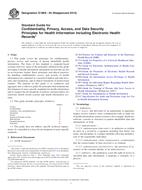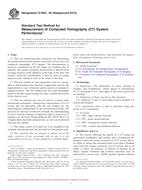Potřebujeme váš souhlas k využití jednotlivých dat, aby se vám mimo jiné mohly ukazovat informace týkající se vašich zájmů. Souhlas udělíte kliknutím na tlačítko „OK“.
ASTM E1869-04(2014)
Standard Guide for Confidentiality, Privacy, Access, and Data Security Principles for Health Information Including Electronic Health Records (Withdrawn 2017)
Automaticky přeložený název:
Standardní příručka pro důvěrnost, soukromí, přístupu a zabezpečení dat Zásady pro informace o zdravotním stavu včetně elektronických zdravotních záznamů
NORMA vydána dne 1.4.2014
Informace o normě:
Označení normy: ASTM E1869-04(2014)
Poznámka: NEPLATNÁ
Datum vydání normy: 1.4.2014
Kód zboží: NS-43388
Počet stran: 9
Přibližná hmotnost: 27 g (0.06 liber)
Země: Americká technická norma
Kategorie: Technické normy ASTM
Kategorie - podobné normy:
Anotace textu normy ASTM E1869-04(2014) :
Keywords:
ICS Number Code 35.240.80 (IT applications in health care technology)
Doplňující informace
| Significance and Use | ||||||||||||||||||||
|
4.1 Many U.S. healthcare and health information systems leaders believe that electronic health information systems that include computer-based patient records will improve health care. To achieve this goal these systems will need to protect individual privacy of patient data, provide appropriate access, and use adequate data security measures. Sound information policies and practices must be in place prior to the wide-scale deployment of health information systems. Strong enforceable privacy policies must shape the development and implementation of these systems. 4.2 The purposes of patient records are to document the course of the patient's illness or health status during each encounter and episode of care; to furnish documentary evidence of the course of the patient's health evaluation, treatment and change in condition; to document an individual's health status; to provide data for preventive care; to document communication between the practitioner responsible for the patient's care and any other healthcare practitioner who contributes to the patient's care; to assist in protecting the legal interest of the patient, the health care facility and the responsible practitioner; to provide continuity of care; to provide data to substantiate insurance claims; to provide a basis for evaluating the adequacy and appropriateness of care; and to provide data for use in continuing education and research. 4.3 Health information is a broad concept. It includes all information related to an individual's physical and mental health, the provision of health care generally, and payment for health care. The patient record is a major component of the health information system. The creation of electronic databases and communication protocols to transfer data between systems presents new opportunities to implement more effective systems for health information, to enhance patient care, reduce the cost of health care, and improve patient outcomes. National standards guide all that have responsibilities for records and information systems containing person identifiable health data and information. 4.4 This guide also acknowledges the large and growing list of health information databases already in existence. These databases have been assembled to pay for services rendered (insurance), to validate the appropriate use of patient services (utilization management), to support policy (national levels), to gather data for research/tracking of specific problems (registries—such as tumor, trauma, birth defects, mental health case management), to prevent the spread of disease (required reporting of communicable diseases such as tuberculosis, gonorrhea, AIDS), and to respond to new uses which are proposed each year. 4.5 National standards delineating principles and practices in the areas of confidentiality, privacy, access, and data security will provide a guide for policy, law, and systems development and a base for standards for electronic health information regardless of its location. |
||||||||||||||||||||
| 1. Scope | ||||||||||||||||||||
|
1.1 This guide covers the principles for confidentiality, privacy, access, and security of person identifiable health information. The focus of this standard is computer-based systems; however, many of the principles outlined in this guide also apply to health information and patient records that are not in an electronic format. Basic principles and ethical practices for handling confidentiality, access, and security of health information are contained in a myriad of federal and state laws, rules and regulations, and in ethical statements of professional conduct. The purpose of this guide is to synthesize and aggregate into a cohesive guide the principles that underpin the development of more specific standards for health information and to support the development of policies and procedures for electronic health record systems and health information systems. 1.2 This guide includes principles related to:
1.3 This guide does not address specific technical requirements. It is intended as a base for development of more specific standards. |
||||||||||||||||||||
| 2. Referenced Documents | ||||||||||||||||||||
|
Podobné normy:
Historická
1.6.2013
Historická
1.3.2013
Historická
1.3.2010
Historická
1.3.2013
Historická
1.6.2009
Historická
1.6.2013



 ASTM E1695-95(2013)..
ASTM E1695-95(2013).. ASTM E1715-01(2013)..
ASTM E1715-01(2013).. ASTM E1744-04(2010)..
ASTM E1744-04(2010).. ASTM E1762-95(2013)..
ASTM E1762-95(2013).. ASTM E1931-09
ASTM E1931-09 ASTM E1935-97(2013)..
ASTM E1935-97(2013)..
 Cookies
Cookies
